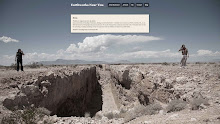
I was reading an essay by Maurice Berger in
Fred Wilson: Objects and Installations 1979-2000 and the information below was mentioned. Smithson referencing the "powerful whirlpools of a mythic past" intrigues me because it focuses on the idea of combining storytelling, art and place. We don't always read about these references because they are much more commonplace then the concept of entropy and the Minimalist aesthetic of stripping all of this away. Part of me wants to find the story and give it its place or more precisely, help to make the artwork mine. Maybe I want to appropriate an earthwork ... not a photographic image of it but the real thing? And what would that resemble? What would that BE?
The two paragraphs that caught my eye are below.
“The site-specificity inherent to the earthworks of Robert Smithson, Robert Morris, and Michael Heizer, for example, relates not only to their specific location on a parcel of land outside of art world contexts, but also to their direct relationship to the social, cultural, ecological, and mythological history of their site. One important aspect of land art, land reclamation, represent an important example of the allegorical in art, because, like many allegorical paintings and stories, it incorporates ruin as a kind of metaphor of cultural decay. Land reclamation projects allegorize the ecological decline of a particular area through a similar, self-conscious relationship to the archeological or geological remains of a ruined past – an allegory that ‘merges physically into its setting… embedded in the place where we encounter it.’ Such earthworks are predicated on a rigors examination of the geological, socio-economic, and often mythic history of their site. “
“’The occurrence of a huge interior salt lake,’ writes Rosalind Krauss of Smithson’s mythological source for the Spiral Jetty on the Great Salt Lake in Utah, ‘had for centuries seemed to be a freak of nature, and the early inhabitants of the region sought its explanation in myth. One such myth was that the lake had originally been connected to the Pacific Ocean through a huge underground waterway, the presence of which caused treacherous whirlpools to form at the lake’s center.’ As in all of Smithson’s land reclamation projects, the jetty’s implicit reference to the lake’s prehistory is also ideological. It’s allusion to the powerful whirlpools of a mythic past serves as an allegory of a tragic, enervated present – a memorial to a section of the Great Salt Lake rendered barren and useless by an adjacent abandoned oil drilling operation. While Smithson’s allegories were broadly social, they were also self-consciously aesthetic, marking as they did the ruination of formalism and the art of the studio and the museum. No longer wiling to live within the limitations o the pristine white cube of the art gallery or museum, these earthworks moved out onto the land. Instead of abstruse, abstract meditations on the spiritual in art or on the retinal possibilities of splattered paint or rigid grids, this art of the land took on bigger, more socially consequential issues, such as the limitations of our natural resources. If some earthworks existed as memorials to a destroyed or depleted geological past, they were also a living and always changing testament to the future potential of art to make a difference.














